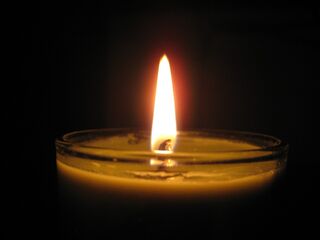Anxiety
Better to Light a Candle Than Curse the Darkness
Research sheds light on three ways to overcome anxiety and find greater hope.
Posted January 14, 2021

As we face the COVID pandemic, political unrest, economic challenges, and multiple crises, many of us are feeling anxious, uncertain, lost in darkness.
We’re also deep in the season of winter, when days are short and nights are long. To find hope in the darkness of winter, our ancestors would light candles and yule logs, a tradition of light in darkness that continues each year with our colorful holiday lights. There’s an old Chinese proverb, “It’s better to light a candle than curse the darkness.” For the past few weeks, I’ve been lighting a candle each night at dinner as a symbol of hope.
Last month the heavens offered a special gift of light, a rare conjunction of Jupiter and Saturn that occurs only once every 800 years, with the planets so closely aligned they appeared as a bright “Solstice Star.” Like the Solstice Star, we can each do our part to bring greater light to ourselves and our world. Here are three ways to begin.
1. Appreciation. We can bring greater light to our lives by practicing appreciation and gratitude—by pausing for a moment to appreciate the natural beauty of the night sky, the sunlight shining through the trees, sparkling icicles, new fallen snow, or the light in a loved one’s eyes. Research at California’s HeartMath Institute has shown how appreciation can move us from draining feelings of worry and anxiety to achieve greater peace of mind. By simply slowing down for a few moments of appreciation, focusing on our hearts and breathing more slowly and deeply than usual, we can experience greater coherence, greater balance emotionally and physically (Childre & Rozman, 2006).
2. Connection. We can bring greater light to ourselves and others with small acts of connection. With what psychologist Barbara Fredrickson (2013) calls “micro-moments of connectivity,” we can connect not only with close friends and family but the grocery store clerk or anyone we encounter in daily life. A simple smile, eye contact, presence, perhaps a kind word—that’s all it takes. These moments of connections benefit both people—to give is to receive. They can help relieve stress, improve our health, raise our mood, and reduce inflammation to promote greater physical and emotional well-being.
These small acts of connection can create a positive ripple effect, spreading through entire communities (Fredrickson, 2013). The same is true for small acts of kindness—helping a neighbor, reassuring a friend or opening the door for someone carrying packages. Research has shown that kindness not only helps us flourish as individuals but that kindness leads to more kindness, creating more hopeful, connected communities (Jung, Seo, Han, Henderson, & Patall, 2020).
3. Compassion. We can create greater light by cultivating greater compassion, feelings of kindness and care for ourselves and others. Research has shown that compassion for others can increase our optimism, energy, and hope. Researcher Thupten Jinpa has found, that “compassion makes us more optimistic ... it is an energized state concerned with the ultimately positive wish for the end of suffering as well as the possibility of doing something about it. ... It lightens our heart and lifts our stress” (2015, xxviii).
Compassion also includes kindness and care for ourselves. As University of Texas psychologist Kristin Neff (2004) has found, self-compassion includes three steps: 1) mindfulness of our feelings, 2) recognizing our common humanity, realizing that it’s only human to make mistakes and suffer, and 3) expressing kindness to ourselves with soothing words and actions.
Research at Stanford University’s Center for Compassion and Altruism Research and Education (Jazaieri et al, 2013) has shown how we can cultivate greater compassion with this loving kindness meditation:
- Mindfully pause to take a few slow, deep breaths, which cuts through the stress reaction, helping us focus, relax, and act more effectively (Jinpa, 2015)
- Begin cultivating loving kindness by first visualizing a loved one—a family member, friend, or even a beloved pet—and sending them feelings of loving kindness
- Expand that loving kindness feeling to include ourselves
- Then extend loving kindness to others we know
- Finally, reach out in a sense of oneness and loving kindness for all beings
What are some ways you can bring greater light to the world by cultivating greater appreciation, connection, and compassion in your life?
__________________
This post is for informational purposes and should not substitute for psychotherapy with a qualified professional.
References
Childre, D., & Rozman, D. (2006). Transforming anxiety: The HeartMath solution for overcoming fear and worry and creating serenity. worry, fatigue, and tension. Oakland, CA: New Harbinger.
Fredrickson, B. (2013). Love 2.0: How our supreme emotion affects everything we feel, think, do, and become. New York, NY: Hudson Street Press.
Jazaieri, H., Jinpa, G., McGonigal, K., Rosenberg, E., Finkelstein, J., Simon-Thomas, E., Cullen, M., Doty, J., Gross, J., & Goldin, P. (2013). Enhancing compassion: A randomized controlled trial of a Compassion Cultivation Training program. Journal of Happiness Studies, 14, 1113-1126;
Jinpa, T. (2015). A fearless heart: How the courage to be compassionate can transform our lives. New York, NY: Hudson Street Press.
Jung, H., Seo, E., Han, E., Henderson, M. D., & Patall, E. A. (2020). Prosocial modeling: A meta-analytic review and synthesis. Psychological Bulletin, 146(8), 635–663.
Neff, K. D. (2004). Self-compassion and psychological well-being. Constructivism in the Human Sciences, 9 (2), 27-37.


